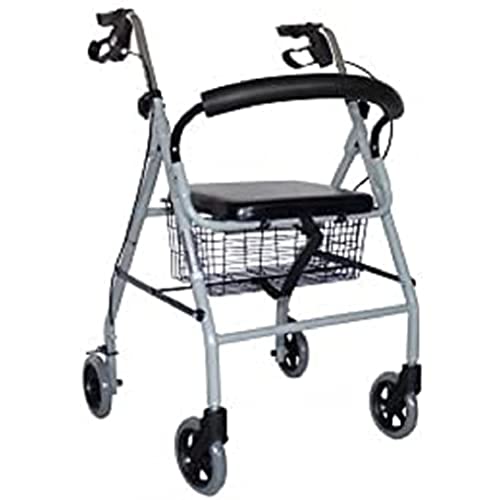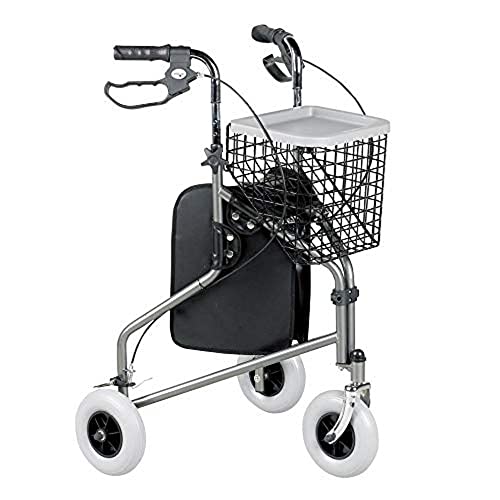Say "Yes" To These 5 Rollator Folding Tips
페이지 정보

본문
 Locking Mechanism For Use With a Foldable rollator wheel chair
Locking Mechanism For Use With a Foldable rollator wheel chairMost rollators are equipped with locks or locking mechanisms that stops them from slamming during storage. This is vital to prevent an ensuing danger during transport.
 The lock is located in the middle of the frame. It can be a button or lever. It's crucial to know how to operate this feature.
The lock is located in the middle of the frame. It can be a button or lever. It's crucial to know how to operate this feature.How to Fold a Rollator
Rollators are excellent mobility aids that provide stability and support for those who require it. They are easy to carry and portable and a variety of models are available to meet different requirements and budgets. 1. However, some may be concerned about how to fold and unfold a rollator red to make it safe to use.
Modern rollators come with easy-to-use mechanisms to fold. The walkers fold quickly and without the need of any tools. This makes them ideal for storage and transport. The locking mechanism ensures the stroller doesn't break when it's being transported or stored and provides users with safety and security.
Modern rollator walkers are not only easy to fold, but they also feature ergonomic designs that ensure the user's safety and comfort. They have a large basket, comfortable handles, and an integrated brake lever that prevents accidental activation. Additionally, they are made of lightweight materials that ensure mobility and comfort.
The traditional rollators weigh more, and they don't support themselves while folded. This makes them difficult to transport or store. Seats are connected to the frame and can't be stored in tight spaces or against objects. Therefore, it is crucial for those who use the rollator wheelchair to understand how to fold their walkers for easier storage and transport.
The first step to fold the rollator is to locate the locking mechanism, which is typically located in the middle of the device's frame. You can lift it gently or release it by following the instructions of the manufacturer. After the locking mechanism has been released, you can fold your walker by pushing the sides in tandem while holding the releases. Continue doing this until the walker is completely folded and securely locked.
You should also check your walker to determine if there are any parts that are loose or signs of wear and damage. Repair any issues immediately to avoid further injuries or damage. It is also recommended to lubricate regularly all moving parts of the walker in order to reduce friction and ensure the smooth operation.
The Crossbar
The crossbar is the bar that supports a rollator's frame and wheels. It is typically made of steel and connects the handlebars to the frame's base. The crossbar provides added stability and strength and holds the basket of the walker and other accessories. Many manufacturers offer a variety of accessories available for their walker models, such as baskets for storage and bags for totes. They can be put on the front or the back of the walker, or placed under the seat.
Many models of walker have a crossbar which can be folded in two directions. This makes them easier to store and transport. This is a significant feature, especially in the event that the walker will be used frequently for travel or long journeys to the grocery store or other locations. Certain models of walker come with a bag which can be used as additional storage.
The brakes are an additional important aspect of a walker that is rolling. They are typically located on the crossbar and handles. There are various kinds of brake systems available, including push-down and cable loop. The push-down brakes require the user to apply downward pressure on the spring-loaded frame in order to stop the walker from sliding. This kind of system might not be well-suited for petite users who might struggle to engage the brakes, or heavier users who accidentally activate the brakes without knowing it.
A cable loop brake system works similar to the brakes of a bicycle. It is activated by squeezing the handlebars or levers simultaneously using both hands. This type of brake system offers greater control and is better for people with weak hand function.
The term "crossbar" is used to refer to the vertical stroke that connects two strokes in the form of a letter. The length, position and thickness of a crossbar will affect the readability of any letterform. This is a major distinction between serif and nonserif fonts. The crossbar that is on the small e is often known as an arm.
The Release Mechanisms
Rollators are a great method to improve mobility and independence for people with physical challenges. These innovative stability aids redistribute the weight of the user evenly across their lower body, reducing stress to muscles and joints and allowing easy and comfortable movement. These mobility aids are equipped with features that can be customized, such as adjustable handlebars and brakes, built-in seating, and storage compartments. They allow users to navigate their surroundings in comfort and safety. These lightweight mobility aids that are portable can be covered by Medicare and Medicaid to make them more affordable.
Carbon rollators are easier to store and transport than traditional walkers. They fold in half and can be placed in the trunk. To do this, take out the basket and then pull up on the crossbar, which exposes a pair of release mechanisms on each side of the frame. Press these release mechanisms while pushing the sides of the frame together until the walking aid expands to its smaller size.
The locking assembly is attached to a top, substantially horizontal support arm 218 joining a pair of substantially vertical tubular legs for the front and rear 220 and 222. Connected to the ends of the rear and front tubular legs are tubular leg extensions telescoping in 226 and 228, respectively. The telescoping extension is able to be turned from an unlocked position to an unlocked position to alter the height.
Once the leg segments for extension are placed in the proper place, a nonsliding handle is positioned at the lever's end. The actuating lever attaches to the housing by way of an extension piece that extends from the frame and a recessed portion dimensioned to accommodate the extension piece. The extension piece and recessive piece provide an axis around which the actuating handle can be moved.
Once the telescoping leg segments are in the appropriate position the locking mechanism is activated a snap button and biasing spring (not shown). This arrangement allows for the user to quickly engage or disengage the folding mechanism, which allows for easy storage and transportation of the walking aid.
The Locking Mechanism
The present invention is a locking mechanism that could be used with the foldable rollator or walker. The invention addresses the need for a lock to use with rollators and walkers which is relatively easy for those with limited dexterity to configure between unfolded and folded positions.
Generally, the device comprising two side frames and the cross brace connecting them includes two handle bars. Two hand brakes are attached to the handles. Each one has an actuator that pins with a plunger on the respective cross bar. When the user presses the hand brakes, the pin actuating spout opens which causes the side frame to turn into a folded state.
One issue with this kind of device is that the lever has to be held in position by a hand as it attempts to depress the plunger actuating pin. This could be a challenge for those with limitations in the strength or dexterity of their hand. The present invention addresses this issue by providing a locking assembly that is operatively coupled with the lever for actuation.
As shown in FIG. 2. The locking assembly comprises a first body portion that has a bore through which is extending an locking pin and a second body part that is rigidly connected to the first body. A lock plate is positioned inside the bore and has an opening that is designed to accommodate a locking portion of the locking pin. A portion of the actuating mechanism between the handle for force application end and the body attaching portion is designed to pivot relative to both of the body components so that the locking pin is moved from a fixed position that prevents rotation of the corresponding tubular leg to a second position where the leg extension that is telescoping can be extended.
When the actuating handle is moved, the locking pin moves from the first position to the second position. This causes the leg extension telescoping can be retracted from the side frame and thereby rotates it into its folded position. This can be done with the hand of the user still securely gripping the handgrip 24 of the side frame. This feature can reduce the amount of effort required to fold and unfold the rollator.
- 이전글What's The Current Job Market For 3 Wheel Jogger Stroller Professionals? 24.10.06
- 다음글HerSecret.fi 24.10.06
댓글목록
등록된 댓글이 없습니다.
